Physical Address
304 North Cardinal St.
Dorchester Center, MA 02124
The patellar and quadriceps tendons along with the patella make up the extensor mechanism of the knee. Disease of the extensor mechanism tendons ranges from tendinopathy to complete rupture. Tendinopathies commonly affect healthy athletes secondary to chronic overuse, but they can also occur in the presence of systemic diseases and endocrinopathies as well as in conjunction with certain medications and hormonal supplements. Ruptures commonly occur in the setting of preexisting tendinopathy. The patella is subject to additional patterns of injury including fracture, maltracking, and dislocation.
Advances in imaging assist in the evaluation and treatment of extensor mechanism disorders. In combination with clinical findings, these studies not only confirm pathology but also provide prognostic information, direct therapeutic approaches, and facilitate surgical planning. Operative and nonoperative treatment plans can be tailored based on patient characteristics, sport-specific demands, and imaging findings. An effective physician must understand the options and indications for both.
The extensor mechanism is composed of the quadriceps, quadriceps tendon, patella, and patellar tendon. The patellar tendon has also been referred to as the patellar ligament. To minimize confusion, the structure is referred to as the patellar tendon throughout this chapter, as the patella is a sesamoid bone found within the extensor mechanism. Pathology and disability can be derived from any of these structures or any adjacent anatomy, such as the patellofemoral articulation.
The patella has multiple static stabilizers including the quadriceps and patellar tendons, the osseous congruence of the patella within the trochlear groove, the medial and lateral retinaculum, and multiple associated ligaments including the medial patellofemoral (MPFL) and patellomeniscal ligaments. The patella is also surrounded by dynamic stabilizers including the rectus femoris, vastus lateralis, vastus intermedius, and vastus medialis (including the vastus medialis obliquus). Each of these muscles is innervated by the femoral nerve, which is composed of the posterior divisions of the second, third, and fourth lumbar spinal nerves. The direct head of the rectus femoris originates at the anteroinferior iliac spine, whereas the reflected head begins superior to the acetabulum. It therefore crosses both the hip and knee joints and can serve to flex the thigh and extend the lower leg. The remaining three muscles of the quadriceps femoris include the vastus lateralis, which originates from the lateral lip of the linea aspera and lateral surface of the greater trochanter; the vastus intermedius, which originates from the anterior aspect of the femoral shaft; and the vastus medialis, which originates from the medial lip of the linea aspera and the distal aspect of the intertrochanteric line. These muscles function as extensors of the knee.
The quadriceps tendon is a layered confluence of the individual insertions from the previously described muscles and attaches to the proximal pole of the patella, enveloping this area of the patella as it advances from proximal to distal. Arteries from the descending branches of the lateral femoral circumflex, the descending geniculate, and the medial and lateral superior geniculate arteries provide the tendon with nourishment, although there is a relatively avascular portion of the tendon just proximal to the patella that measures approximately 1.5 × 3 cm. The patellar tendon is a continuation of the quadriceps tendon beyond the distal pole of the patella and inserts on the tibial tuberosity. The blood supply of the patellar tendon is not as rich as that of the quadriceps tendon. It is carried by vessels from the infrapatellar fat pad as well as the inferomedial and lateral geniculate arteries ( Fig. 107.1 ). The proximal and distal aspects are relatively avascular and thus more susceptible to injury.
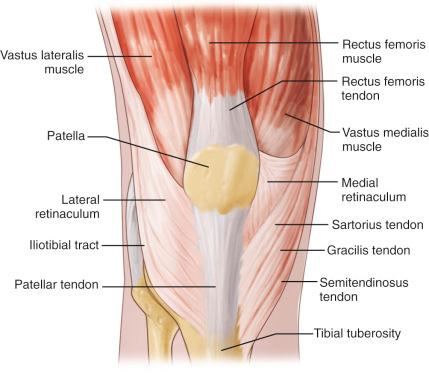
The patella itself is the largest sesamoid bone in the body. It ossifies from a single center that usually appears in the second or third year of life, though notably its appearance may be delayed until the sixth year. Rarely, the bone ossifies from two adjacent centers. Ossification is completed around the age of puberty, and incomplete ossification may result in a bipartite patella. The incidence of bipartite patella ranges between 2% and 8%, most commonly involving the superolateral aspect of the patella; when present, it is found approximately 50% of the time on the contralateral side.
The patella is a flat triangular bone with a thick superior border that provides an attachment for the quadriceps tendon. The apex is pointed distally and provides an origin for the patellar tendon. The posterior articular surface is divided by a vertical ridge and then again into thirds by two horizontal prominences. The lateral facet is larger than the medial facet. The lower facets engage with the trochlear groove in early flexion followed by the middle and then the upper facets with increased knee flexion. In full flexion, the most medial aspect of the patellar articular surface, the crescentic or odd facet, is the main contact point. Patellofemoral contact is initiated at about 20 degrees of flexion, and the patella undergoes approximately 7 cm of excursion in relation to the femur from full extension to flexion. The forces generated across the patellofemoral joint are tremendous, ranging from half of the total body weight for normal walking to nearly eight times the body weight for jumping from a small height. The articular surface of the patella is the thickest in the body so that it may counteract these forces, reaching thickness of more than 1 cm in depth.
The blood supply to the patella is from a vascular anastomotic ring lying in a thin layer of loose connective tissue covering the rectus expansion ( Fig. 107.2 ). The main vessels contributing to this anastomotic ring are the descending genicular artery, the four medial and lateral superior and inferior geniculate arteries, and anterior tibial recurrent artery. Nutrient vessels pass obliquely into the anterior surface of the patella from this complex network in a retrograde fashion from the distal and middle thirds of the patella. Disruption of this supply by injury or surgical dissection can result in avascular necrosis. Rates of 3.5% to 24% have been reported after patellar fracture.

The knee consists of three compartments: the medial tibiofemoral, lateral tibiofemoral, and the patellofemoral. The patella increases the extensor moment arm of the knee extensors by transmitting the longitudinal contractile force at a greater distance from the knee axis of rotation ( Fig. 107.3 ). The efficiency of the extensor mechanism increases 1.5 times through this advantage. Patellofemoral contact shifts distally to proximally with increasing degrees of flexion ( Fig. 107.4 ). Ascending stairs can create forces within the patellar tendon that are 3.2 times the body weight, and the greatest forces on this structure as well as the quadriceps tendon occurs at about 60 degrees of knee flexion.
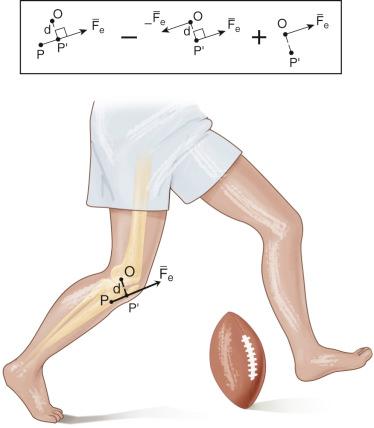
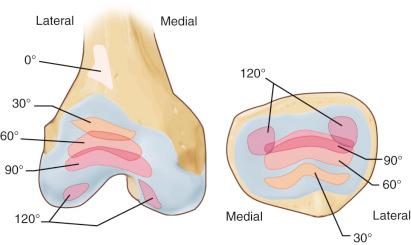
Huberti and colleagues described the extensor mechanism force ratio , which compares the forces on the patellar tendon and the quadriceps tendon at various knee flexion angles. The ratio is greater than 1.0 (indicating more force on the patellar tendon) when the knee is in less than 45 degrees of flexion and the distal pole of the patella articulates with the trochlear groove, thus providing a mechanical advantage for the quadriceps tendon because of a relatively larger moment arm due to the added length of the proximal, nonarticulating patella. Conversely, with knee flexion angles greater than 45 degrees, the ratio drops below 1.0.
A tendon is a complex material consisting of collagen fibrils embedded in a matrix of proteoglycans. Both quadriceps and patellar tendons are mainly composed of water in the extracellular matrix. The predominant cell type found within tendons is the fibroblast. This cell is present in the space between the parallel collagen bundles ( Fig. 107.5 ). The tendon is composed primarily of type I collagen and contains a high concentration of glycine, proline, and hydroxyproline. The secondary structure is the arrangement of each chain in a left-handed configuration, the tertiary structure involves three collagen chains combined into a collagen molecule, and the quaternary structure is related to the organization of collagen molecules into a stable, low-energy biologic unit based on the association of its amino acids with adjacent molecules. This quarter-stagger arrangement of adjacent collagen molecules results in oppositely charged amino acids being aligned. A great deal of energy is required to separate these molecules, accounting for the overall strength of this structure ( Fig. 107.6 ).
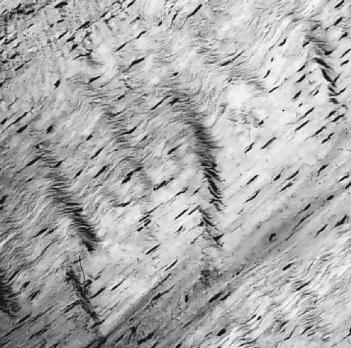
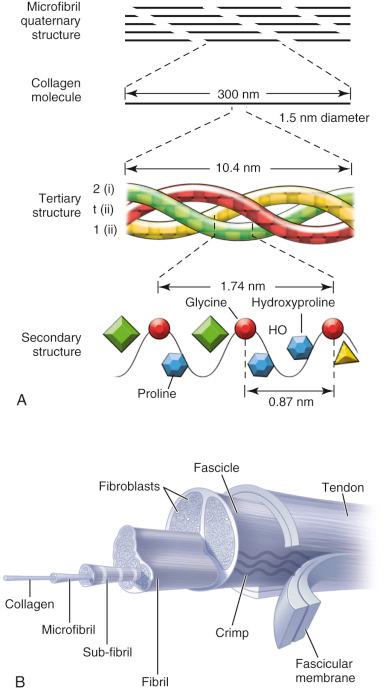
The tendon possesses one of the highest tensile strengths of any soft tissue in the human body for two reasons. First, it is composed of collagen, which is one of the strongest fibrous proteins in the body. Second, tendon collagen fibers are arranged parallel to the direction of the tensile force. The elastic modulus of human tendon ranges from 1200 to 1800 megapascals (MPa), the ultimate tensile strength ranges from 50 to 105 MPa, and the ultimate strain ranges from 9% to 35%.
Patellar tendinopathy is the result of tendinosis of the patellar tendon or degeneration of the tendon itself, with inadequate restorative capabilities. Colloquially, it is known as “jumper's knee” owing to its prevalence in athletes participating in jumping sports. It can be the result of extrinsic causes, such as repetitive mechanical overload, as well as intrinsic causes, such as anatomic abnormalities and imbalances of the surrounding static and dynamic stabilizers. Tendinosis is commonly found in the posterior and proximal patellar tendon adjacent to the inferior patellar pole. Diagnosis and management of this disorder can be challenging, and our understanding continues to evolve. Quadriceps tendinopathy is much less commonly described, although it likely shares many pathologic attributes with patellar tendon disease.
The nomenclature associated with tendon pathology can be somewhat confusing given the variability of descriptions of different disease processes in the literature. Maffulli and colleagues recommended use of the term tendinopathy as a generic descriptor of a range of tendon pathology. Tendinitis refers to the presence of inflammatory cells on histologic evaluation. In patellar tendinopathy, early pathologic alterations in the presence of repetitive microtrauma to the patellar tendon include inflammatory cell invasion, tissue edema, and fibrin exudation in the paratenon but not the tendon itself, referred to as paratenonitis . Continued microtrauma can overwhelm reparative capabilities, leading to chronic inflammation. The development of patellar tendinosis is thought to result from chronic peritendinitis and is characterized by histopathologic findings of mucoid degeneration, tendolipomatosis, calcifying tendinopathy, and neovascularization but not the presence of inflammatory cells.
Yuan et al. and Cook et al. presented evidence that the earliest identifiable morphologic changes in tendinosis occur in tenocytes and not collagen fibers. Microscopic evaluations of degenerative tendons demonstrate a paucity of inflammatory cells, changes in tenocyte morphology and density, accumulation of glycosaminoglycans, and collagen fiber thinning and disarray with or without neurovascular proliferation. Lian et al. studied biopsy specimens in patients with patellar tendinopathy and found increased cellularity compared with controls as well as a higher number of apoptotic cells. On a molecular level, an increased expression of cyclooxygenase-2, transforming growth factor β-1, glutamate, and prostaglandin E2 can be found in the presence of tendinopathy, indicating an abnormal healing response.
Cyclic tensile loading of tendons is required to maintain normal tendon health. This process is referred to as mechanotransduction and couples tendon stretch with a cellular biologic response. Excessive mechanical stretch stimulates an anabolic response, whereas normal stimuli promote a catabolic response. Continued loading in the face of a weakened tendon can lead to an accumulation of injury, thus inhibiting the healing capacity and resulting in an overuse injury.
Tendons can become injured as a result of direct trauma, such as laceration or contusion, or indirect trauma through tensile overload. It is generally accepted that healthy tendons do not rupture in the setting of physiologic forces. When tensile overload of an otherwise healthy extensor mechanism occurs, it more commonly results in a transverse fracture of the patella rather than failure of the adjacent tendons. Zernicke et al. estimated that a force of 17.5 times body weight is required to cause rupture in healthy patients, supporting the notion that normal tendons do not tear. No widely accepted classification system exists for patellar tendon or quadriceps tendon ruptures. Clinically it is helpful to group them based on the location, configuration, and chronicity of rupture.
Ruptures of the patellar tendon are thought to occur less frequently than ruptures of the quadriceps tendons. They are usually seen in patients younger than 40 years and are more commonly associated with healthy, active patients with underlying tendinopathy, whereas quadriceps tendon ruptures are more common in patients older than 40 years and are often associated with underlying systemic medical conditions, such as diabetes mellitus. Both are more common in males.
When tendon ruptures do happen, they typically occur within the context of preexisting tendon pathology. Kannus and Jozsa studied specimens from spontaneously ruptured tendons in 891 patients and compared them to age- and sex-matched controls. Under light and electron microscopy, all ruptured tendons demonstrated abnormal findings, with a majority demonstrating signs of degenerative changes. Two-thirds of the unruptured tendons demonstrated no pathology, whereas the remainder showed findings similar to those seen in the ruptured cohort. Characteristic histopathologic patterns in the ruptured tendons included combinations of hypoxic degenerative tendinopathy, mucoid degeneration, tendolipomatosis, and calcifying tendinopathy.
Mechanical testing performed on the patellar tendon has shown tensile strains to be less at the midbody than at the origin and insertion sites on the patella and tibial tuberosity. At peak load just prior to tendon failure, the end-region strain at the insertion site is three to four times than that seen in the midbody. Thus healthy tendon rarely fails within its substance; if this occurs, the physician must consider external factors such as metabolic derangements ( Box 107.1 ).
Hyperparathyroidism
Calcium pyrophosphate deposition
Diabetes mellitus
Steroid-induced tendinopathy
Fluoroquinolone-induced tendinopathy
Osteomalacia
Chronic renal insufficiency
Gout
Uremia
Systemic lupus erythematosus
Rheumatoid arthritis
Metabolic abnormalities have been shown to influence the physiologic status and biomechanical function of tendons. These conditions can be innate, induced, or iatrogenic. Diabetes mellitus, for example, can compromise the blood supply and limit the reparative abilities. Rheumatoid arthritis, gout, renal failure, hypothyroidism, and chondrocalcinosis can also lead to tendinopathy and ruptures. Local and systemic corticosteroid injections have been shown to limit the inflammatory phase of healing, and tendon ruptures have been documented after the administration of these agents. Fluoroquinolone antibiotics, such as levofloxacin and ciprofloxacin, have been shown to alter the extracellular matrix in tendons and can influence healing after injury. Ciprofloxacin also induces interleukin-1β–mediated matrix metalloproteinase-3 release. Matrix metalloproteinases are a family of proteolytic enzymes that have the ability to degrade the extracellular matrix network and facilitate tissue remodeling. Fluoroquinolones can also inhibit tenocyte metabolism, reducing cell proliferation and collagen and matrix synthesis. Additionally, investigations have noted decreased biomechanical properties of healing patellar tendon with administration of anti-inflammatory drugs compared with acetaminophen and controls. Anabolic steroid use is also associated with an increased risk for tendon ruptures. Polymorphisms in genes coding for collagen may be implicated in tendon rupture. Galasso et al. described a case report of a patient with collagen type V α-1 polymorphism who incurred spontaneous, simultaneous quadriceps tendon ruptures.
Patellar fractures are relatively uncommon, comprising approximately 1% of all skeletal injuries. A recent epidemiologic study noted a bimodal distribution of injuries, with young males and elderly females more commonly injured. The mechanism of injury is either a direct blow to the patella or an indirect force transmitted to the patella through the extensor mechanism. Fracture patterns are usually representative of the injury mechanism as well as patient characteristics, such as bone density. Indirect forces typically produce nondisplaced or minimally displaced transverse fractures of the central or distal third and, uncommonly, a vertical fracture. Blunt injury to the patella either from a direct blow or from a fall onto the flexed knee produces a comminuted stellate fracture pattern. These fractures can be broadly divided into displaced and nondisplaced fractures. In the setting of a clearly displaced fracture, a concomitant retinacular injury should be suspected.
Isolated quadriceps tendinopathy has not been well described in the contemporary literature and is often mentioned in the context of bilateral involvement due to underlying medical comorbidity. A few reports have been made of sequelae due to calcific tendinitis leading to chronic enthesopathic changes and, in some cases, bilateral tendon rupture. The majority of publications describing extensor mechanism tendinopathy focus on the patellar tendon. Patellar tendinopathy is essentially an overuse injury and is commonly seen in athletes who participate in sports that involve jumping, such as volleyball and basketball. Commonly, patients report discomfort in the distribution of the proximal patellar tendon and distal patellar pole. Pain usually starts without a clear traumatic etiology but can be related to an increase in activity. It may be present only after activity in mild cases and progress to continuous symptoms in more advanced cases.
Zwerver et al. noted in nonelite athletes that the prevalence of jumper's knee varied between 2.5% and 14.4% for different sports and that males were twice as likely to be affected. They also identified sport-specific loading characteristics, higher body weight, taller stature, and younger age as risk factors for the development of patellar tendinopathy. Lian et al. studied the prevalence of jumper's knee among elite athletes from various sports. Cyclists were unaffected, whereas male basketball and volleyball players demonstrated a prevalence of 32% and 44%, respectively. Players routinely exhibited symptoms lasting longer than 2 years, and affected athletes had significant pain and functional impairment. Hägglund et al. studied professional male soccer players and found that 1.5% of all reported injuries were patellar tendinopathies and that each season 2.4% of players were affected. The investigators noted no significant differences with regard to prevalence or incidence between play on artificial versus natural turf.
Ferretti et al. demonstrated a linear relationship between training volume and the prevalence of tendinopathy among volleyball players. They also demonstrated a higher prevalence of tendinopathy among players who trained on a harder surface. Backman and Danielson showed a correlation between low ankle dorsiflexion and an increased risk of patellar tendinitis in junior elite basketball players, likely due to more compensatory energy absorption by the patellar tendon. A systematic review by van der Worp et al. found limited evidence that weight, body mass index, waist-to-hip ratio, leg-length difference, arch height, quadriceps and hamstrings flexibility, quadriceps strength, and jump performance were possible risk factors for the development of patellar tendinopathy. Symptoms may occur in young adults undergoing a rapid phase in growth. In these cases, a relative discrepancy in tendon length may be found compared with adjacent bony structures. This finding occurs when the tendon does not lengthen as quickly as the adjacent bone.
The mechanism of injury associated with patellar and quadriceps tendon rupture is typically involves forced knee flexion accompanied by a strong knee extensor muscle contraction. Patients with often describe a pop or tearing sensation accompanied by intense and immediate pain. Immobilization of the extremity in extension provides pain relief. In a study of patellar tendon ruptures in National Football League (NFL) players, nearly half reported antecedent symptoms, which can implicate underlying tendinopathy as a preceding injury.
Patellar fractures result from either an indirect force applied through strong contraction of the extensor mechanism against a flexed knee or from a direct force, such as a fall or blunt trauma to the anterior knee. The subcutaneous location of this bone places it at risk for injury from direct impact. Traumatic separation of a bipartite patella can also occur, and patients with this condition may have an antecedent dull ache or pain prior to the traumatic episode. Patients with patellar fractures usually present with a painful, swollen knee after either direct trauma or a fall in which an attempt is made to stop suddenly. Weight bearing is painful and, depending on the competence of the medial and lateral retinacula, the patient may or may not be able perform a straight leg raise.
A patient may have tenderness over the patellar tendon and signs of inflammation, such as redness, swelling, warmth, and crepitation secondary to paratenonitis. Pain is often centered on the distal patellar pole and the proximal part of the patellar tendon. Tenderness to palpation may be present with the knee in extension and absent with the knee in flexion. The patient may have a feeling of “bogginess” centered over the tendon itself and may also have pain with resisted extension and with full passive flexion. The decline squat test involves a single-leg squat to 30 degrees on the affected extremity, which elicits symptoms by increasing the load on the patellar tendon.
Blazina et al. established a classification for patellar tendinopathy ( Table 107.1 ). In stage 1, pain is present only after activity. In stage 2, pain is present at the beginning of activity, disappears after a warm-up, but may reappear with fatigue. In stage 3, pain is constant, both at rest and with activity. In stage 4, the patellar tendon is completely ruptured. The Victorian Institute of Sport Assessment Questionnaire (VISA) is a validated patient-reported outcome measure commonly utilized to assess and follow patients with patellar tendinosis and is frequently reported in research on the matter.
| New | Old | Definition | Histologic Findings | Clinical Signs and Symptoms |
|---|---|---|---|---|
| Paratenonitis | Tenosynovitis Tenovaginitis Peritendinitis |
Inflammation of only the paratenon whether or not it is lined by synovium | Inflammatory cells in paratenon or peritendinous areolar tissue | Cardinal inflammatory signs: warmth, swelling, pain, crepitation, local tenderness, and dysfunction |
| Paratenonitis with tendinosis | Tendinitis | Paratenon inflammation associated with intratendinous degeneration | Same as above, with loss of tendon, collagen fiber disorientation, and scattered vascular ingrowth but no prominent intratendinous inflammation | Same as above, often with a palpable tendon nodule, swelling, and inflammatory signs |
| Tendinosis | Tendinitis | Intratendinous degeneration due to atrophy (e.g., aging, microtrauma, or vascular compromise) | Noninflammatory intratendinous collagen degeneration with fiber disorientation, hypocellularity, scattered vascular ingrowth, occasional local necrosis, or calcification | Often a palpable tendon nodule that may be asymptomatic but may also be point tender; swelling of the tendon sheath is absent |
| Tendon strain or tear | Symptomatic overload of the tendon with vascular disruption and inflammatory repair response | Three recognized subgroups: each displays variable histologic characteristics from purely inflammation with acute hemorrhage and tear to inflammation superimposed on preexisting degeneration, to calcification and tendinosis changes in chronic conditions; in the chronic stage, it may be (1) interstitial microinjury, (2) central tendon necrosis, (3) frank partial rupture, or (4) acute complete rupture | Symptoms are inflammatory and proportional to vascular disruption, hematoma, or atrophy-related cell necrosis; symptom duration defines each subgroup:
|
Physical examination of a tendon rupture presents with a triad of pain, inability to actively extend the knee, and a palpable gap. Patients are unable to actively extend the knee but may be able to maintain extension against gravity through an intact retinaculum. Clinicians must take care to thoroughly examine the knee in someone with a suspected patellar or quadriceps tendon rupture, particularly in patients who can exhibit some extensor mechanism function. Knee aspiration with an intra-articular local anesthetic can relieve pain, permit an adequate physical examination, and allow for an accurate diagnosis. A gap or palpable depression adjacent to the patella is pathognomonic for tendon rupture ( Fig. 107.7 ). Despite their superficial nature, patellar and quadriceps tendon ruptures can frequently be overlooked or missed. Siwek and Rao performed a retrospective analysis of 36 quadriceps and 36 patellar tendon ruptures and found that 38% of these injuries were initially misdiagnosed. Diagnosis may be more difficult when the injury is accompanied by hemarthrosis, which can mask the presence of a gap. Intense pain may limit willingness to comply with examination. Diagnostic failure rates of 10% to 50% have been reported, and delays in diagnosis have ranged from days to months.
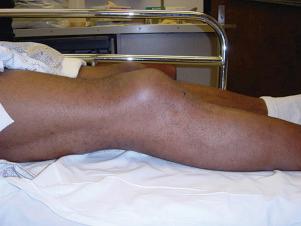
Localized tenderness, soft tissue swelling, and a hemarthrosis are typically present. It is important to examine the skin around the knee for abrasions and lacerations. Because of the superficial position of the bone, signs of an open or impending open fracture must be explored and ruled out. With a displaced fracture, a gap between the two fragments may be palpated. The integrity of the extensor mechanism also needs to be evaluated. Sometimes an accurate exam may be limited by pain. Similar to patellar or quadriceps tendon ruptures, aspiration of the hemarthrosis followed by an injection of intra-articular local anesthetic can be performed to allow for a more accurate exam and verify the status of the surrounding retinaculum.
Imaging is not routinely necessary for the initial treatment of patellar or quadriceps tendinosis. Standard radiographs, however, are commonly obtained upon initial evaluation in the clinic setting. Findings can be normal or may include traction osteophytes at the distal pole of the patella, tendon calcification, and even decreased bone mineral density at the sites of attachment.
Ultrasound and magnetic resonance imaging (MRI) are more sensitive modalities and are commonly employed when nonoperative treatment fails to provide relief or the diagnosis is in question. Ultrasound evaluations can localize tendinosis as a hypoechoic signal within the fibers of the patellar tendon. Other findings include tendon thickening, paratenon irregularity, intratendinous calcifications, neovascularization, and patellar pole errosions. Warden et al. performed MRI and gray-scale and color Doppler ultrasound on 30 patients with clinically diagnosed patellar tendinopathy and 33 activity-matched asymptomatic control subjects. These investigators concluded that ultrasonography was more accurate than MRI in confirming clinically diagnosed patellar tendinopathy. They added that the combination of gray-scale and color Doppler ultrasound best confirms clinically diagnosed patellar tendinopathy because of the high sensitivity of gray scale and the strong likelihood that symptomatic persons would demonstrate a positive color Doppler test ( Fig. 107.8 ).
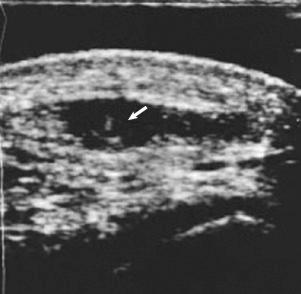
Sagittal MRI may demonstrate thickening of the patellar tendon, especially on the posterior, central, or medial aspects ( Fig. 107.9 ). MRI may also demonstrate foci of abnormal signal intensity in the posterior portion of the proximal patellar tendon ( Fig. 107.10 ). The severity of findings on imaging has not been clearly correlated with the severity of reported symptoms, although the presence of structural findings in asymptomatic athletes may predict a greater chance of future symptoms. Edema in the inferior patellar pole marrow or the infrapatellar fat pad can portend inferior functional results and slower recovery in patients undergoing operative treatment for patellar tendinopathy.
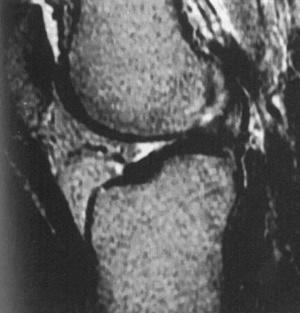
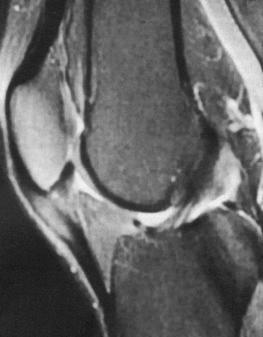
Although mostly a clinical diagnosis based on history and physical examination, various imaging modalities may be useful in the diagnosis of patellar and quadriceps tendon ruptures. Findings on radiographs may include the obliteration of the quadriceps or patellar tendon shadows, calcific densities at the proximal or distal patellar poles that may be avulsed, and patellar height alterations due to the tethering effect of the uninjured end of the tendon. In the case of patellar tendon ruptures, increased density of the infrapatellar fat pad as well as loss of sharp margins and waviness of the patellar tendon are consistently seen in addition to patella alta.
The Insall-Salvati ratio is a commonly used method for measuring patellar height, although it has high intra- and interobserver variability. This ratio is calculated by dividing the patellar tendon length by the greatest diagonal distance of the bony patella and is normally between 0.8 and 1.2 ( Fig. 107.11 ). The Blackburne-Peel method has higher interobserver reliability and is less affected by knee position. A line is drawn perpendicular to the tibial plateau extending to the inferior articular margin of the patella. The length of this line is divided by the length of the articular surface of the patella. Normal values for males and females are 0.805 and 0.806, respectively ( Fig. 107.12 ), with values greater than 1.0 representing patella alta. Patellar tendon ruptures result in higher ratios ( Fig. 107.13 ), whereas quadriceps tendon ruptures result in lower ratios and, in some cases, anterior tilt of the patella away from the trochlear groove ( Fig. 107.14 ). Other techniques for measuring patellar height, including the Caton-Deeschamps index and the relationship of the Blumensaat line to the inferior pole of the patella at 30 degrees of knee flexion, are also helpful.
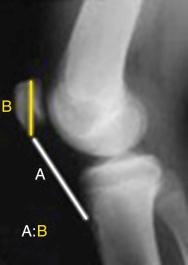
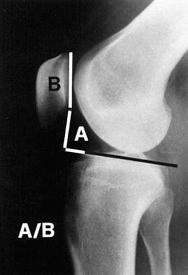
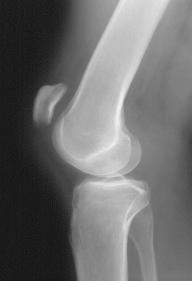
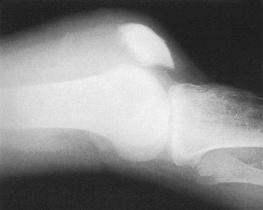
High-resolution ultrasonography has been shown to be an effective means of evaluating both the patellar and quadriceps tendons in acute and chronic tendon injuries. MRI is the most sensitive test available to evaluate the injured tendons. It also provides accurate information about the location of injury, presence of additional injuries, such as concomitant meniscal tears; in addition, it can help with surgical planning ( Fig. 107.15 ).
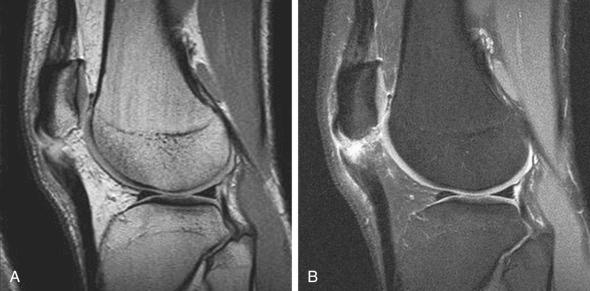
Become a Clinical Tree membership for Full access and enjoy Unlimited articles
If you are a member. Log in here